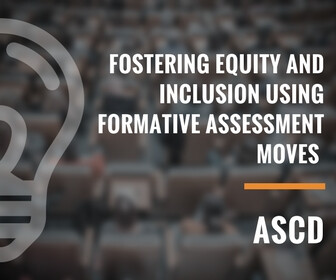What if you could use assessment to change the dynamics of your classroom? What if assessment for learning became a way of teaching that brought more students into the classroom conversation? What if making “formative assessment moves” brought about more equity, more inclusion, and more authentic participation NOW?
What if you could use assessment to change the dynamics of your classroom? What if assessment for learning became a way of teaching that brought more students into the classroom conversation? What if making “formative assessment moves” brought about more equity, more inclusion, and more authentic participation NOW?
To reach your goal of helping your kids’ thinking and feelings become more visible, it can be as simple as making these formative assessment (FA) moves: priming, posing, pausing, probing, bouncing, tagging, and binning. (We will say more in a minute….)
But let’s remember: We have known for years that assessment for learning AKA formative assessment brings students’ voices to life in economically, socially, and linguistically diverse classrooms.
So, let’s make a move today.
But first, here is a primer – the FA moves – to help us get started moving in the same direction, with a common grammar of “high leverage” evidence-based practice. Each move actively invites us to take a new, dynamic stance towards “assessing” for learning:
Priming—is building on your students’ background knowledge and creating a formative assessment-rich, equitable classroom culture
Posing—is asking questions in relation to learning targets across the curriculum that elicit Habits of Mind
Pausing—is waiting after powerful questions and rich tasks to encourage more student responses, supporting them to think aloud and use speaking and listening skills related to academic language
Probing—is deepening discussions, asking for elaboration, and making connections using sentence frames and starters
Bouncing—is sampling student responses systematically to broaden participation, manage flow of conversation, and gather more “soft data” for instructional use Tagging—is describing and recording student responses without judgment and making public how students with different styles and needs approach learning in real time
Binning—is interpreting student responses with a wide range of tools, categorizing misconceptions and “p-prims,” and using classroom generated data to make more valid and reliable instructional decisions on next steps in the lesson and unit
Priming is key. If you want your students to “buy into” the formative assessment game and go beyond “doing school,” they will need to believe you are serious about equity and inclusion. One way to prime for equity in your classroom is through a visible example: “There are no right or wrong answers to this question,” “We wait, think, then share,” “What a great question! Why don’t we ask that to everyone?” Each of these expressions affirms your commitment to inclusion. Posted on the wall, projected on slide, or repeated after your checks for understanding—these verbal, written, and visual cues change the tone.
Posing questions seems easy. Asking questions in relation to well-defined visible learning targets is more challenging. Whether you are guided by Webb’s DOK, Bloom’s Taxonomy or the Habits of Mind (Duckor & Perlstein, 2014)—each question should invite students to share, discuss, and risk a “first draft” answer. Here are a few to jump start high order thinking, speaking, and listening practices—for you, your colleagues, and the students in a unit from our book:
Habit of Mind
Initial Pose
Follow up Probes
Evidence
How do you know what you know?
How do you know? Can you state your source? How credible is this? Are you sure? Can you back it up with more evidence?
Perspective
From whose point of view is this being presented?
Are there other perspectives? Whose perspective is missing? Whose perspective seems to matter most?
Connections
How is this event or work connected to others? What causes what?
Which connections cause other events or ideas? How are these things connected? Is there a relationship? What else influences these actions or events?
Supposition
What if things were different?
Is there another possibility? Could events have turned out differently? What are the alternatives? What effect might it have? What other hypotheses can you formulate?
Relevance
Who cares? Why is this important?
Who cares? How is it relevant to our lives? What effect does it have? Will anything change as a result of studying this material?
Making posing, pausing, and probing moves centered on Habits of Mind is essential to opening the door for your students. These moves—whether delivered as written or verbal prompts—invite students into your lesson and larger subject discipline.
Bouncing goes to the heart of deep equity. In a classroom where all student voices matter, more than a few hands will be called upon. We love the eager beavers—but where is the love for the cynical Sams, frustrated Freds, and silent Sallies! We must make our sampling of student responses to our quick writes, hook/hinge questions, and probes more systematic and visible. Equity sticks, randomizer apps, even a stuffed monkey can send the message: each child has an idea, belief, even misconception worth exploring. The key is to widen the net!
If bouncing gets us to include more voices, tagging says: We care enough to make your ideas a part of today’s learning experience. In fact, by scribing and routinely honoring what everyone says in response to an important question or prompt, the whole class begins to see that learning is the process of coming to agreement on what counts, together in real time. Tagging moves also promote the act of describing and recording student responses—without judgment or criticism. When students scribe other students’ thinking—on the dry erase board or in a online learning space—students begin to see how working with different styles and needs makes us stronger as a community.
Tagging all student responses says to each and every student, “I care about what you say—enough to tag it.”
Don’t fall into the misconception that a “wrong answer” written on the whiteboard will cause an outbreak of mistaken thinking. Even if “an epidemic” occurs, you’re up to the task of leveraging such a response to further student understanding. Tagging all students’ contributions epitomizes “meeting students where they are,” something all teachers who care about equity strive to do.
Feedback is at the center of becoming a formative assessor. All of these moves leads to more effective formative feedback (Wiggins, 2012). In our last chapter of our recent book Mastering Formative Assessment Moves: 7 High-Leverage Practices to Advance Student Learning (2017), we make the distinction between binning-for-grading and binning-for-feedback. Both matter, but each has a different purpose. When assessing for learning “on the fly” we need to interpret student responses with a wide range of tools, we need to categorize misconceptions and “p-prims,” and most of all, we need to use the “real time” classroom-generated data to make more valid and reliable instructional decisions. Do we stop? Do we re-teach a portion of the lesson tomorrow? Do we revise our curricular activities and formative assessment strategies as we prepare for the next unit? Binning-for-feedback looks for what can be built upon in students’ responses and work. It is actively listening for assets and strengths. It is the essence of equity and inclusion for those prepared to move beyond slogans.
However you decide to answer these questions and deepen your teaching and assessing practice, make an FA move! We will be glad to join you.








